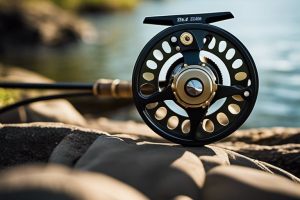There’s a world of difference between freshwater and saltwater fly reels, and knowing which one to choose can make or break your fishing experience. Freshwater reels tend to be lighter and simpler, while saltwater reels are robust, corrosion-resistant, and designed to handle larger, powerful fish. Understanding these distinctions helps you select the right gear for your adventure, ensuring that you’re prepared for whatever the water throws your way. Dive into the specifics that matter, and elevate your angling pursuits with confidence.
The Great Divide: Freshwater vs. Saltwater Fly Fishing
Your choice of fly reel can significantly influence your fishing experience, especially when comparing freshwater to saltwater environments. Each presents unique challenges, requiring specific features in your gear. Understanding these differences is imperative for both novice and seasoned anglers who want to maximize their success on the water.
The Unique Challenges of Freshwater Fly Fishing
Great landscapes punctuate the world of freshwater fishing. You find yourself at serene lakes, meandering rivers, or even mountain streams. Freshwater environments often present various fish species, including trout, bass, and panfish. These species are generally less powerful than their saltwater counterparts, allowing you to use lighter reels and lines. However, you must remain vigilant about the changing conditions. Fluctuating water levels and varying temperatures can be delicate factors that influence both your fly selection and presentation.
The Demanding Environment of Saltwater Fly Fishing
An entirely different canvas unfolds in the saltwater realm. Here, you encounter larger, stronger fish like tarpon, bonefish, and marlin. The challenges are amplified by the elements—wind, tide, and saltwater itself can wreak havoc on your gear. Saltwater reels need to withstand corrosion and should be constructed with durable materials designed for rigorous use. You require robust drag systems and strong lines capable of handling harder runs and faster fights. Don’t underestimate the power of the sea; it demands your respect.
Divide your approach between these two worlds. In saltwater, the pressure on your gear is considerable, given the fish’s strength and the harsh conditions. A reel that can handle the salt is paramount. Features such as sealed drags and anodized aluminum bodies become necessities rather than luxuries. You’ll benefit from a reel designed to resist the corrosive effects of saltwater, ensuring longevity and reliable performance when the big one strikes.
Reel Materials: A Key Difference
Little do many anglers realize that the choice of materials in fly reels plays a crucial role in their performance across different water types. Concerning freshwater versus saltwater fly reels, understanding the differences in materials can greatly enhance your fishing experience. Freshwater reels often prioritize lightweight construction for ease of use, while saltwater reels must handle harsher conditions and resist corrosion.
Freshwater Reels: Lightweight and Corrosion-Resistant
To cater to the needs of freshwater fly fishing, these reels are typically made from lightweight alloys and plastics. This design allows for smooth casting and retrieval without adding unnecessary weight to your setup. The materials are typically coated or treated to resist corrosion, ensuring that they maintain their integrity over time. This focus on weight and corrosion resistance keeps your gear agile and your catch responsive.
To further enhance their functionality, freshwater reels often feature simple drag systems that can easily be adjusted on the fly. This minimalist approach allows you to focus on the fish rather than fiddling with complex mechanisms, which can be detrimental to your performance on the water. The lightweight materials also contribute to better line management, enabling you to cast with precision and accuracy.
Saltwater Reels: Heavy-Duty and Fully Sealed
To effectively combat the rigors of saltwater fishing, saltwater reels are constructed with robust materials such as anodized aluminum or high-grade stainless steel. These reels are designed to endure the briny depths and resist the corrosive effects of saltwater. Additionally, they often feature fully sealed designs to keep out sand, mud, and salt, allowing them to perform consistently under demanding conditions.
Understanding the importance of these heavy-duty materials can set you up for success on your fishing trips. A saltwater reel’s durable construction not only protects the internal components but also offers you the reliability necessary when battling larger, more aggressive fish. By investing in a reel that withstands the challenges of saltwater, you ensure that your fishing adventures remain enjoyable and productive, allowing you to focus on the thrill of the catch rather than the maintenance of your gear.
Drag Systems: Stopping Power and Smoothness
Clearly, the drag system in a fly reel is a critical feature that determines how effectively you can land a fish. Freshwater and saltwater environments offer different challenges, and your choice of reel reflects these demands. The drag system’s purpose is to apply controlled resistance when a fish pulls line from the reel, preventing the line from breaking and allowing you to tire the fish out. For a deeper understanding of the nuances between the two types, you can explore Saltwater vs. Freshwater reels….
Freshwater Reels: Delicate Drag Systems for Small Fish
Freshwater fly reels are designed for delicate drag systems that cater to smaller fish species. These reels often feature lighter materials, providing a smooth and subtle drag that allows you to manage fights without overpowering your catch. When you’re targeting trout or panfish, the ability to feel every tug on the line is crucial. The subtlety of these systems can make a significant difference, especially with more finicky fish that might shy away from a hard pull.
The drag settings on freshwater reels typically range from minimal to moderate, which is conducive to a game that often involves finesse. A drag that is too tight can snap lighter lines, while one that is too loose may allow fish to escape. Thus, you will find yourself adjusting the drag throughout your outing to match the size and species of fish you pursue. With the right freshwater reel, you harness the limit of precision required for a successful day on the water.
Saltwater Reels: Beefed-Up Drag Systems for Large Fish
One of the stark contrasts when it comes to saltwater fly reels is their beefed-up drag systems built to tackle larger fish species, like tarpon or bonefish. In saltwater environments, fish are often stronger and more aggressive, requiring a robust drag system that can handle intense pressure. These reels use advanced materials such as stronger metals and carbon fiber, which not only increase their durability but also enhance their ability to deliver smooth and strong resistance throughout the fight.
Small adjustments in the drag on saltwater reels can yield significant results. The high-stakes nature of saltwater fishing means that when a large fish makes a run, you need to have full confidence in your equipment. A well-designed drag system must withstand the relentless pulling power of larger fish while allowing you to control the fight effectively. This makes for a thrilling experience, where every ounce of your gear’s capacity is tested against the might of the ocean’s denizens.
Line Capacity: How Much is Enough?
After you select your fly reel, the next significant consideration is line capacity. This impacts your ability to handle the fish you aim to catch. Different environments demand different capacities. For freshwater fishing, you often encroach into smaller bodies of water where fish typically have less power to make long runs. Therefore, your line capacity does not need to be extensive.
Freshwater Reels: Limited Line Capacity for Smaller Fish
Line capacity in freshwater reels typically ranges from 80 to 150 yards of backing. This is sufficient for chasing species like trout or panfish. These fish, while spirited when hooked, don’t usually make long, desperate escapes. As a result, a lighter reel with a narrower spool serves you well. You can save weight in your gear, allowing for a more enjoyable day on the water.
Saltwater Reels: High Line Capacity for Long Runs
One of the key features of saltwater reels is their substantial line capacity. Reels designed for saltwater fishing often hold upwards of 200 yards, sometimes exceeding 300 yards, of backing to accommodate hard-fighting species like tarpon or tuna. These fish are known for their stamina and strength, leading to long and powerful runs. A solid line capacity ensures you’re prepared for whatever challenge they present.
Capacity in saltwater reels isn’t just about holding more line; it’s about the security that comes with it. You want to be ready for those unexpected bursts of energy, where every yard counts. This means when you’re battling a spirited fish, you can focus on your technique instead of worrying about running out of line. You also have the versatility to switch between different line types or sizes, tailoring your setup for the day’s fishing adventure. In saltwater scenarios, your reel becomes a vital part of the battle, making ample line capacity vital.
Size and Weight: Finding the Right Balance
To choose the right fly reel, size and weight are crucial factors. These characteristics influence not only your comfort but also your casting efficiency and the reel’s overall performance. An angler needs to match these elements to the specific type of fishing they will encounter, whether in freshwater lakes or saltwater expanses.
Freshwater Reels: Compact and Lightweight for Easy Casting
Size matters when it comes to freshwater reels. You’ll find that these reels are often designed to be compact, which makes them easier to handle and allows for precise casting. The lighter build reduces fatigue, letting you spend more time fishing. This is especially significant when you’re casting frequently to catch trout or panfish in small streams and ponds.
With a freshwater reel, the goal is efficiency. A lighter reel means you can focus more on your technique, leading to better control and accuracy. Freshwater reels typically weigh less than their saltwater counterparts. This allows you to enjoy a day on the water without being weighed down, enhancing your overall experience.
Saltwater Reels: Larger and Heavier for Increased Power
Lightweight designs are not the hallmark of saltwater reels. Instead, these reels are generally larger and heavier to handle the increased demands of saltwater fishing. You need a robust construction that can withstand the relentless pull of bigger fish and the harsh marine environment that can corrode lighter materials. A heavier saltwater reel gives you the leverage and durability required when battling strong species, such as tarpon or tuna, which demand added power during intense fights.
A saltwater reel’s bulk not only aids in managing more significant forces but also offers enhanced line capacity. The size ensures you have enough backing and allows for smoother drag systems, which is vital when a fish makes a swift run. As you reel in your catch, you’ll appreciate the stability and strength that these larger reels provide, ensuring you’re ready for whatever the ocean throws your way.
Additional Features: What You Need to Know
Once again, the distinction between freshwater and saltwater fly reels goes beyond just their construction. When you dive deeper into the features of each, you uncover nuances that can either enhance your experience or make it a struggle. These reels are more than just tools; they are crucial components of your fishing success, tailored to different environments and challenges.
Freshwater Reels: Simple and Intuitive Design
Design is straightforward and user-friendly in freshwater reels. You can expect lightweight materials that make them easy to handle for hours on end. Most freshwater reels offer a direct and simple drag system, allowing you to focus on your casting and presentation without worrying about complicated adjustments. With fewer moving parts, maintenance is a breeze, which means you spend more time fishing and less time tinkering.
The simplicity of freshwater reels is not a shortcoming; rather, it provides you with an intuitive experience. You can quickly get a feel for the gear, allowing you to concentrate on what really matters: the hunt for fish. When you’re out on the water, you need gear that feels natural in your hands, something freshwater reels consistently deliver.
Saltwater Reels: Advanced Features for Taming the Beast
Advanced features are crucial when it comes to saltwater reels. Fish in saltwater are often larger and put up a stronger fight, which means your equipment needs to perform under pressure. Saltwater reels are designed to endure harsher conditions, employing corrosion-resistant materials and intricate drag systems that can handle the incredible bursts of speed and power these fish exhibit.
| Corrosion Resistance | Materials such as anodized aluminum are used to withstand saltwater’s corrosive effects. |
| Advanced Drag System | Smoother drag systems to handle powerful runs and abrupt fights. |
| High Line Capacity | Designed to hold increased amounts of line for longer runs. |
| Sealed Bearings | Minimize the intrusion of salt and grit, enhancing longevity. |
A true saltwater reel will have features tailored for durability and efficiency. The complexity of their design can be intimidating, but this added sophistication allows for superior performance on the water. If you aim to catch larger species, a high-end saltwater reel is an investment worth making. You’ll find innovative drag systems and robust construction that are built for endurance.
- Corrosion-resistant materials keep your reel functioning well through saltwater exposure.
- Sealed systems protect critical components, prolonging life and performance.
- Multiple drag settings give you greater control over your battle with big fish.
| Weight | Freshwater reels are lighter; saltwater reels are built heavier and sturdier. |
| Maintenance | Freshwater reels need minimal upkeep; saltwater reels require regular cleaning and care. |
| Cost | Saltwater reels often cost more due to their advanced features. |
| Drag Systems | Freshwater reels typically have simpler drag systems compared to the complexities of saltwater reels. |
Final Words
Summing up, when choosing between freshwater and saltwater fly reels, you must understand the key differences in their construction and capabilities. Freshwater reels are typically lighter and simpler, designed to handle the common fish you’ll encounter in lakes and rivers. Saltwater reels, on the other hand, are built to withstand harsher environments. They offer more durability, corrosion resistance, and a stronger drag system to deal with larger and more powerful saltwater species. The right reel does more than just hold your line; it enhances your fishing experience and helps you land that trophy catch.
Your choice depends on where you plan to fish and the species you aim for. If you’re venturing into the salt, consider researching related gear such as Saltwater v. Freshwater Fly Rods. This knowledge will aid you in pairing the right rod with your reel, ensuring you’re fully equipped to face whatever the water might throw at you. In the end, whether you prefer the tranquility of a tranquil lake or the thrill of the ocean, having the right gear makes all the difference.
FAQ
Q: What are the main differences between freshwater and saltwater fly reels?
A: The primary differences between freshwater and saltwater fly reels lie in their materials, drag systems, and overall durability. Freshwater reels are generally lighter and made from materials that are suitable for less abrasive environments, such as aluminum or plastic. Saltwater reels, on the other hand, are built to withstand harsh conditions, utilizing corrosion-resistant materials like anodized aluminum or stainless steel. Additionally, saltwater reels often feature stronger drag systems to handle the larger, faster fish typically found in saltwater environments.
Q: Why is corrosion resistance important for saltwater fly reels?
A: Corrosion resistance is crucial for saltwater fly reels because saltwater is highly corrosive and can quickly damage reels that aren’t specifically designed to resist it. Reels made for saltwater fishing usually include sealed components and protective coatings that prevent saltwater from coming into contact with the internal parts, ensuring longevity and reliability. A reel that lacks these features can suffer from rust and deterioration, leading to diminished performance and potentially costly repairs.
Q: Do drag systems differ between freshwater and saltwater fly reels, and how does this affect performance?
A: Yes, drag systems do differ between freshwater and saltwater fly reels. Saltwater reels are designed with stronger and often more intricate drag systems to handle the significant power and speed of larger saltwater species. These systems are typically smoother and can provide higher pressure settings than freshwater counterparts. On the other hand, freshwater reels generally feature simpler drag systems that are sufficient for the typically smaller fish found in freshwater environments. The performance of a fly reel is heavily influenced by the drag system, as it directly affects the ability to control a fish during a fight.


